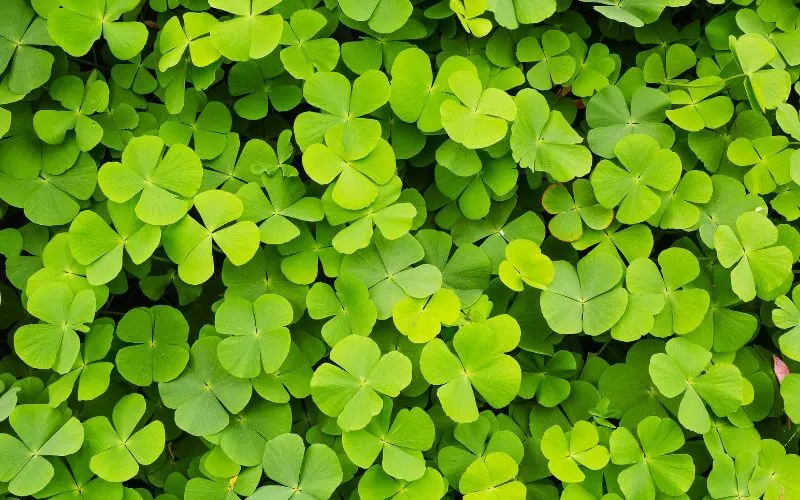
Table of Contents
Traditional Irish Symbols
Irish people and their Irish culture are known the world over. They have certainly helped to put a small island on the world stage.
There are many symbols that have become synonymous with Ireland and Irish cultural heritage. This article explores some of the main Irish symbols and meanings, as well as some of their surprising origins.
List of Irish Symbols
- Shamrock
- Irish Harp
- Claddagh Ring
- Celtic Cross
- Celtic Symbols
- Irish Flag
Shamrock
While the Harp is the official symbol of Ireland, the shamrock as the unofficial one is probably equally well known.
For centuries, Ireland has been associated with the shamrock.
Legend has it that the origins of this association date back to when St. Patrick explained the mystery of the Holy Trinity using the three leaves on one single stem.
Today, the shamrock is seen as a universal symbol encompassing all things Irish.
The national airline, Aer Lingus, proudly displays a shamrock on its logo. Enter any Irish souvenir shop and you will be bombarded by souvenirs covered in shamrock of all kinds.
Plus on St. Patrick’s Day itself, people wear sprigs of shamrock pinned on their clothes!
What is shamrock?
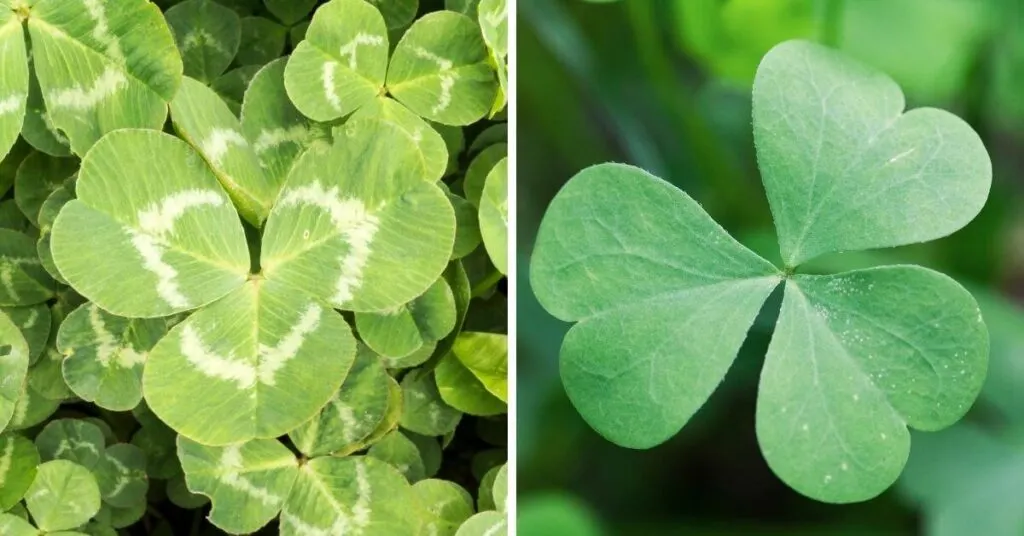
Interestingly, there is no single botanical species called “shamrock”.
The word Shamrock comes from Seamair óg, or young clover in Irish. Usually the term “shamrock” is applied to the species Trifolium dubium, or Trifolium repens in Ireland.
This clover species is a member of the legume or Fabaceae family which can fix nitrogen from the air and transfer it to the soil and acts as an important fodder crop.
With much of Ireland dominated by agriculture, there is no doubt that clover swards, such as Trifolium dubium and Trifolium repens help to contribute to Ireland’s landscape of forty shades of green.
In America, the Oxalis, or wood sorrels, with the similar leaf shape to Trifolium has been adopted as the “shamrock” in many places.
Each year the American president receives a bowl of Shamrock from the Irish Taoiseach (Prime Minister) as a present for St. Patrick’s Day in a tradition that dates back to the 1950s.
Is the Shamrock a symbol of good luck?
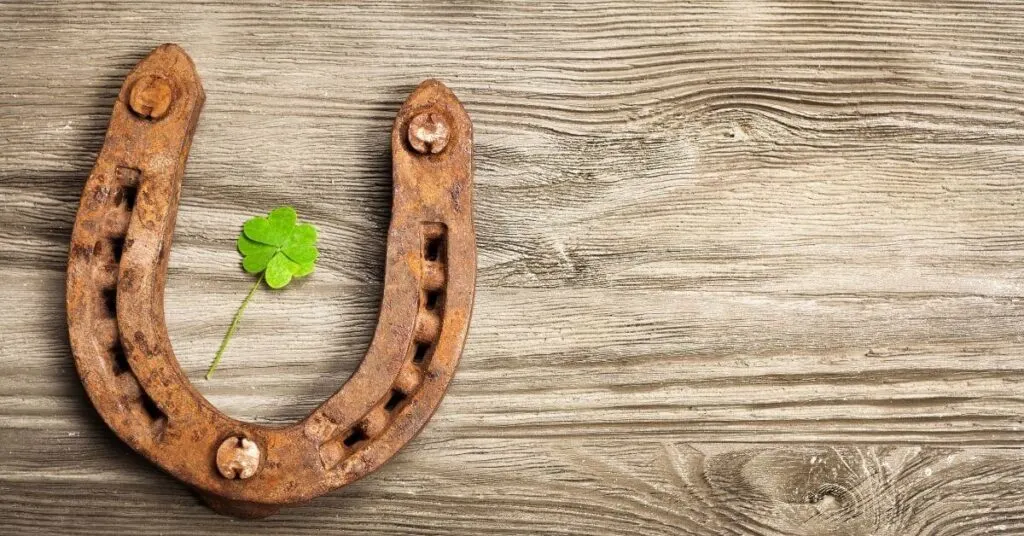
Shamrocks are one of the best known Irish symbols of luck, but more typically four leaf clovers are considered lucky.
Clovers typically have three rather than four leaves per stem. Finding that lucky fourth leaf could be a bit tricky in a sward of grass. This additional leaf is most likely caused by a genetic mutation that occurs roughly in 1 out of 5000 clover specimens.
The world record holder found 166 real four leaf clovers in one hour! Now that is lucky!
Sometimes clover can have five leaves (or more leaves) on a single specimen. The five-leaf clover, which is also known as a rose clover, is thought to be particularly special by collectors.
Irish Harp
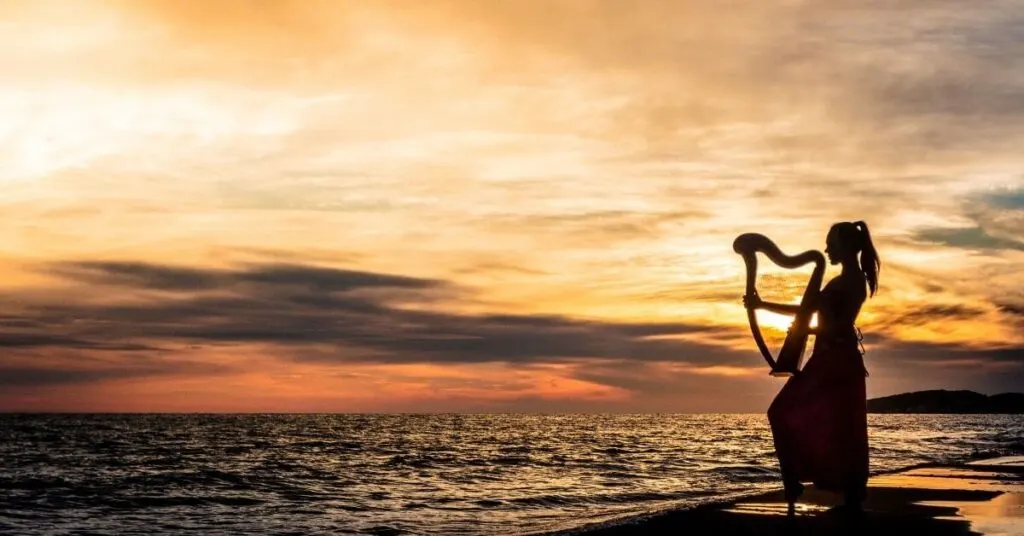
The Irish harp has been the national symbol of Ireland and Irish heritage for centuries.
It is the national emblem of Ireland and is displayed on Irish Euro coins and official documents such as the presidential seal, birth certificates and passports.
Several organizations and companies also feature the harp on their logos, such as Ryanair and the National University of Ireland.
Harp music often has an ethereal quality and the haunting melodies are often captured in Irish music.
Try not to get too confused by the name Irish harp. Generally speaking, the Irish harp is also referred to as the Celtic harp, gaelic harp, Clàrsach, and Cláirseach, although there may be some minor differences between them.
History of the Irish Harp
In pre-Christian times, strung instruments would have mostly likely been a variation of a lyre.
This type of instrument was favored by the Celts and is featured in Celtic mythology. Thus it is no wonder that harps of various forms and shapes are associated with Celts in Scotland, Wales and Brittany.
Harpers (harpists play the more modern pedal harps) of ancient times, were likely to be well educated individuals that had a certain status in society somewhat similar to a bard or a poet.
During early Christian times lyre-like instruments were used to accompany the reading of religious texts and psalms. Later harpers would also entertain at banquets and other events.
Modifications to this musical instrument around the 9th century lead to the development of a harp-like instrument with a form of soundbox, a triangular shape and with strings of different lengths.
Several weather carvings, such as that on Muiredach’s Cross in Monasterboice, Co. Louth, depict the changes to the instruments.
Unlike the large harps that spring to mind today, these early Irish harps were likely to have been small, easy to carry and were played with the finger nails rather than the pads of the fingers.
This early Irish traditional harp had its high times during the medieval period and all but disappeared by the 19th century, along with the skills of its traditional harpers.
The 19th century was when the Neo-Irish harp was invented by John Egan. This is the harp that we commonly associate with Ireland today and is based on the design of the orchestral pedal harp.
Irish Harp as a National Symbol
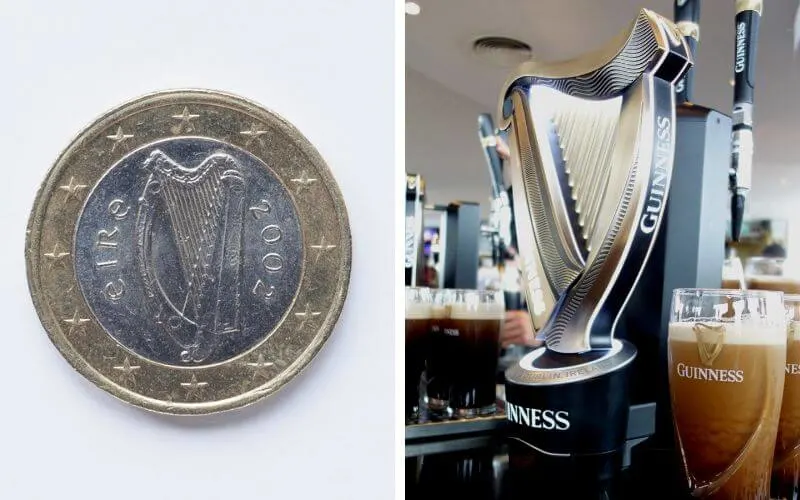
The Irish harp is a state symbol found on all governmental documents and stamps, as well as Irish coins. In every image, the flat board of the Irish harp is on the right.
This is because Guinness registered the trademark Irish harp symbol before the Irish State did so. The Guinness harp has the flat board on the left side and faces the right.
The design for both the State emblem and the Guinness harp is based on the Brian Boru harp that is on display in the Long Room of Trinity College Dublin.
Don’t be fooled by the name, it is thought that the harp dates back to about the 14th century and could not possibly be the actual harp of Brian Boru, the High King of Ireland from the 10th century.
The Irish harp also served as the inspiration behind the recently built Samuel Beckett Bridge in Dublin.
Irish Claddagh Ring
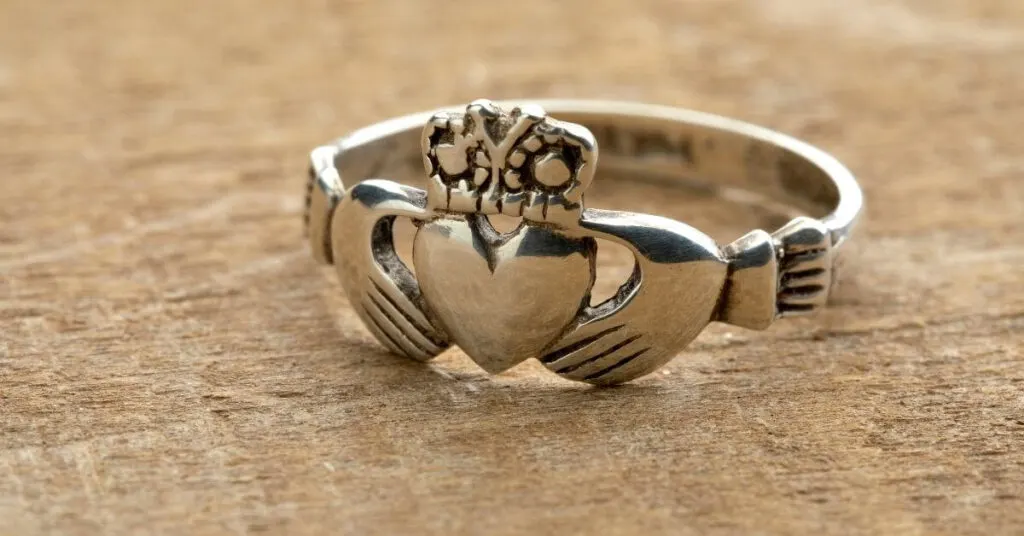
The iconic Irish Claddagh ring or as it is sometimes called, the Irish ring or Irish wedding ring is one of the most recognisable and well loved of all Irish jewelry designs.
The modern design of this ring features a pair of hands that clap a heart with a heart on the top.
It is thought that the Claddagh Ring design is likely based on a fede ring from Roman times. Fede rings depicted hands symbolically clasped in friendship, love or even marriage.
There is more to this ring than meets the eye though. Not only does it reveal a lot about the wearer, the man credited with creating the modern design has quite a remarkable life story too!
Claddagh Ring Meaning
The meaning behind the Claddagh design is similar to the Fede ring with the heart representing love, the hands friendship and the crown loyalty.
Due to its symbolic meaning, the Claddagh ring has commonly been associated with marriage, wedding rings and engagement rings.
While both men and women wear Claddagh rings, they are traditionally passed down through the female line of a family.
Find out more about the meaning of the Claddagh Ring in our post here.
How to wear a Claddagh Ring
In fact, the way that a Claddagh ring is worn can be used to reveal a relationship status.
Claddagh ring worn on left hand
- Heart facing inwards mean the wearer is married
- Heart facing outwards means the wearer is engaged
Claddagh ring worn on right hand
- Heart facing inwards mean the wearer is in a relationship
- Heart facing outwards means the wearer is single
History of the Claddagh Ring
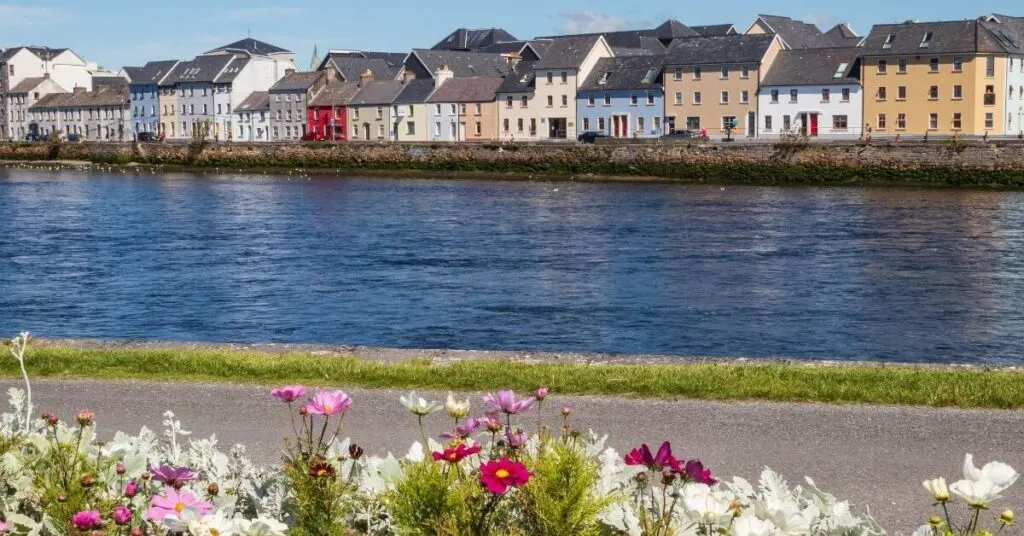
Though there are several people credited with the modern design of the Claddagh ring, based on historical sources, Richard Joyce was probably responsible for creating the design as we know it around 1700.
A native of Galway and member of one of the merchant tribes of Galway, Joyce is said to have been taken prisoner by Algerian pirates en route to the West Indies. He was later sold into slavery to a wealthy goldsmith Moor.
Joyce’s natural talent did not escape the eye of the Moor, who had him apprenticed in the trade of a goldsmith and he became very skilled in his trade.
When in 1689 King William III decreed that all his subjects be released the Moor Goldsmith tried to bargain with Joyce to stay, but Joyce returned to his native Galway and established his own successful goldsmith business.
A gold Claddagh ring that Joyce made will be one of the key exhibits in the new Atlantic Museum that is due to be opened in Galway in 2023.
The family run business of Thomas Dillon’s Claddagh Gold has been in business since 1750 and was granted the Royal patent for the Claddagh design. This allows them to call themselves the original makers of the Claddagh ring to this day.
Celtic Cross
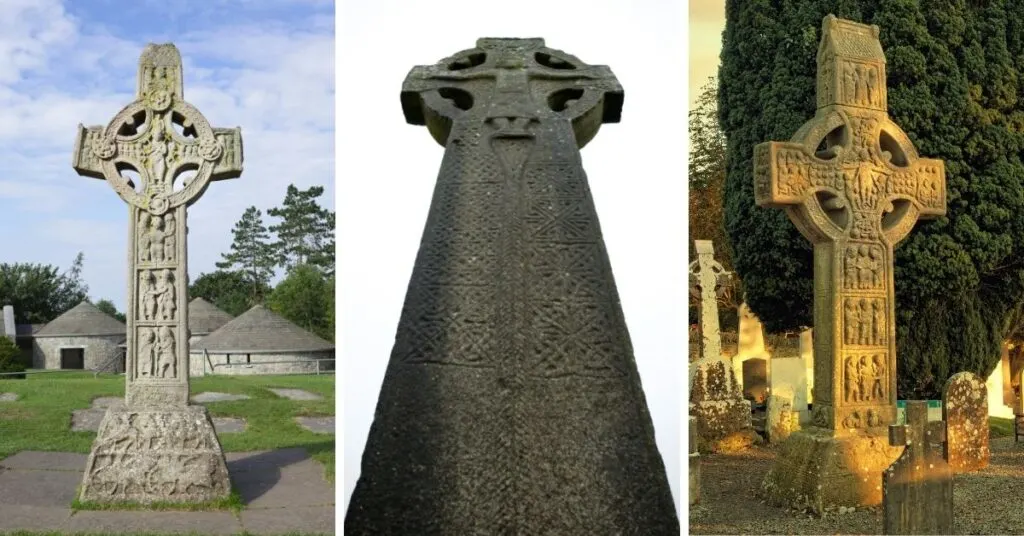
The Celtic Cross is also known as an Irish Cross, Irish Celtic Cross, Celtic High Cross or High Cross.
Regardless of which name is used, this Christian symbol has a very identifiable cruciform shape and is associated with Celtic Christianity, Ireland and Irish culture.
It is worth mentioning that Celtic Crosses have a very strong Irish connection, they are not only found in Ireland, but in areas that Celtic culture also thrived, such as Scotland, Wales and elsewhere in Europe.
History of the Celtic Cross Development
Saint Patrick is sometimes given credit for the design of the Celtic Cross, but if we look at the development of Celtic cross design it evolved over the following centuries.
The earliest Christian cross structures were probably made of wood and did not survive over time.
Stone pillars with incised designs are the first form of surviving Christian Stone Crosses. These were basically slabs of stone that did not resemble any cruciform shape.
Some of the earliest examples have been found in Ireland. A good example of which is the Riasc Pillar from a monastic site near Baile an Fheirtéiraigh on the Dingle Peninsula dating back to the late 6th century.
The techniques and designs for Celtic underwent rapid improvement during the following centuries. By the 7th century cross forms were being carved out of the rock.
During the 8th and 9th century ringed Celtic crosses were created, often with highly detailed relief carvings.
Celtic crosses were decorated with elaborate carvings of spirals and triskeles (La Tène design), as well as with Celtic knots and zoomorphic patterns.
Celtic Cross Meaning
Various suggestions have been put forward as to the meaning behind the shape of the Celtic cross.
One theory is that the arms of the cross signify the four cardinal directions of the compass: north, south, east and west. The circle at the junction points could possibly represent unity, a halo or it might date back to pre-Christian worship and be a symbol of the sun.
Some Neolithic and Bronze Age Art works from Europe also feature a cross in the center of a circle, which was known as a sun cross or wheel cross. Some indications suggest that this may have served as inspiration for the Celtic Cross.
Other possibly more modern theories put forward suggest that the four arms stand for the elements of Fire, Air, Earth and Water or Mind, Body, Soul and Heart.
Modern Celtic crosses are sometimes used as headstones in cemeteries.
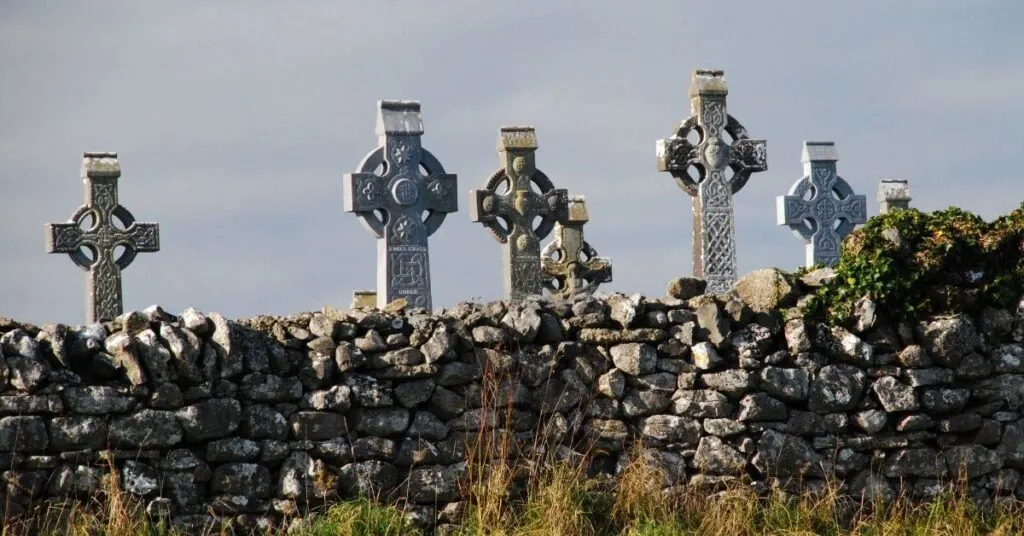
Purpose of Celtic Crosses
As the vast majority of the population during the early Christian period were illiterate, one of the purposes of Celtic Crosses was to act as a visual aid to help understand the teaching of the bible.
The Cross of Moone is a tall, slender example from the 10th century illustrates the biblical stories of Adam and Eve, as well as the loaves and the Fishes.
Muiredach’s Cross in Monasterboice is one of the most ornate of all of the Irish Celtic Crosses and depicts various scenes from both the Old and New testaments.
Other purposes for Celtic Crosses are thought to include acting as focal points for religious meetings and perhaps even marking land boundaries.
Celtic Cross Symbol
The Celtic Revival of the 19th century helped to spotlight these masterfully carved works of art and triggered a reappreciation for Celtic Crosses and Celtic Cross designs.
Nowadays the Celtic Cross symbol is a popular religious, as well as aesthetic pleasing design frequently featured in Celtic jewelry.
As well as St. Brigid’s Cross designs, Celtic Cross jewelry is also popular for religious, as well as aesthetic reasons. A wide range of Celtic cross jewelry designs for rings, pendants, necklaces and earrings are crafted in either precious metals such as gold or silver, or also in more unique materials such as Connemara marble.
Additionally, the Celtic Cross tattoo is also a popular inked Celtic design.
Celtic Symbols and Celtic Knots
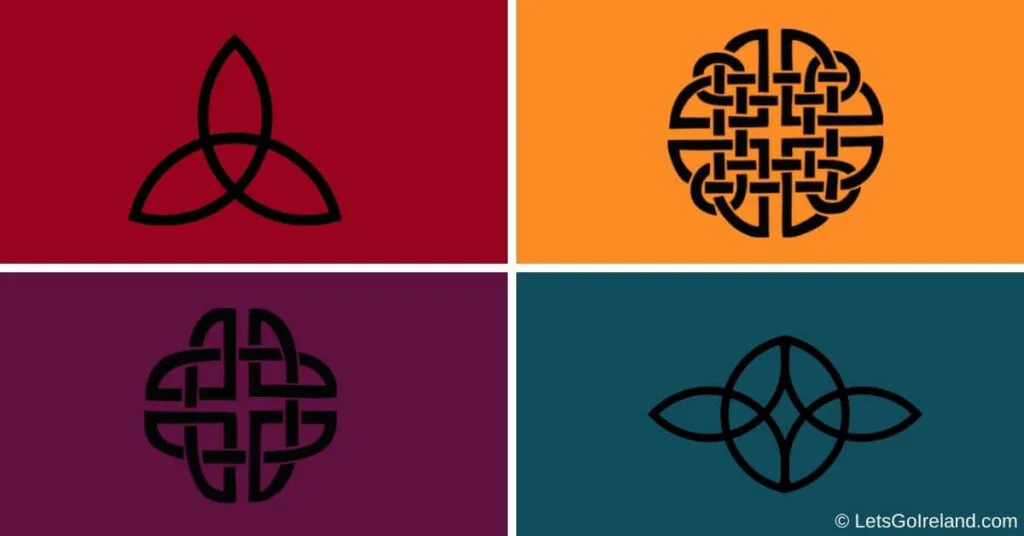
The influence of Celtic culture can still be seen in Ireland today. In fact, many of the ancient Celtic symbols and Celtic knot designs are almost synonymous with Ireland.
To be fair, Ireland is not the only country to have been influenced and benefited from Celtic culture.
While this article focuses on traditional Irish symbols, you can read all about Celtic Symbols an Celtic Knots in our other articles.
The article about Celtic Symbols and Meanings delves into the rich history and origins behind the popular Celtic symbols such as the spirals, the Triskelion and Celtic Tree of Life as well as other so-called Celtic symbols.
Interestingly, Ireland was one of the areas at the forefront of Celtic knot design and manuscript illustration in the 6-9th centuries.
While the intricate Celtic knots and Celtic knot patterns cannot be uniquely identified as Irish Celtic symbols, they did arise from the Insular Art period that developed in Ireland and Britain around this time.
The unending nature of Celtic knot design can be seen in the complex design of the Dara knot stemming from the roots of the oak tree or through the simplicity of the Serch bythol.
Strong symbolism is also behind some of the Celtic knots such as the Triquetra or Trinity Knot or also the Dara Celtic knot (also believed to be the Celtic Symbol for strength or as it is sometimes referred to as the Irish symbol for strength).
In the article about Celtic Knot meaning and origins, you can read about what the original Triquetra symbol represents and how it is now linked to eternal spiritual life through its Christian connection with the Holy Trinity.
Irish Flag

Last but not least, the Irish national flag is one of the most prominent Irish symbols known universally around the world.
The flag of Ireland consists of three vertical bands of green, white and orange. Each color in this flag is uniquely symbolic.
Since at least the late 1700s, the color green has been associated with Irish republicanism and thus the largely Roman Catholic population of the south of Ireland.
Irish Protestants are connected with the color orange, through the association with the Dutch Prince William of Orange (King William III).
The white band in the middle of the Irish flag symbolizes a lasting truce between the nationalists and unionists on the island of Ireland.
The first record of the Irish tricolor flag dates back to March 1848 when it was flown by the Young Irelanders leader, Thomas Francis Meagher in the city of Waterford. Prior to this point, the green flag, or green harp flag as it was also known, was recognized as an unofficial flag of Ireland during the time of British rule.
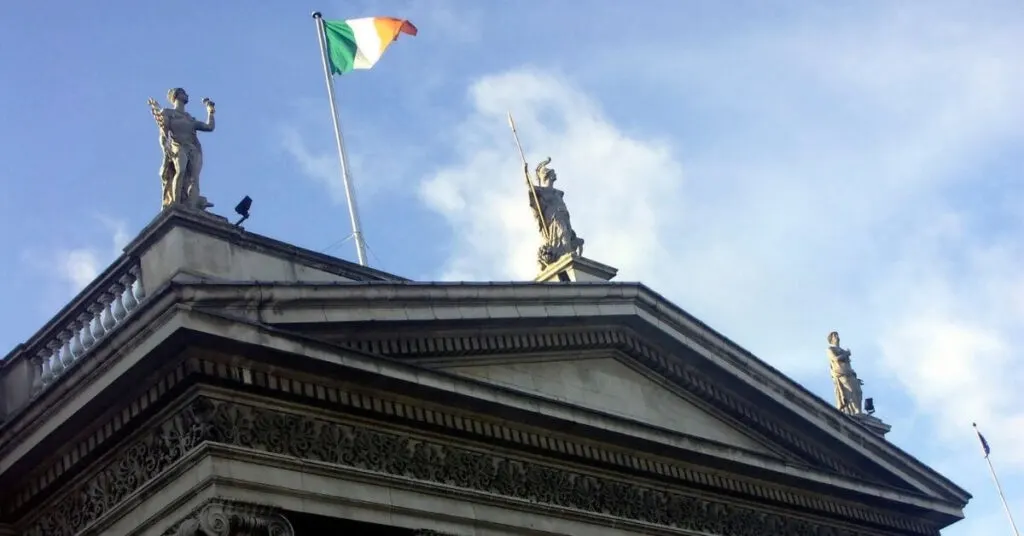
There is hardly any evidence of the tricolor flag being used until the time of the 1916 Easter Rising, where it was flown above the GPO (General Post Office) in Dublin. This turning point in Irish history helped pave the way for the Irish Free State in 1922.
After the Easter Rising, the green, white and orange flag grew in popularity and has been recognized by the Irish constitution since 1937.
The Irish flag colors are sometimes incorrectly shown as green, white and gold.
Interested to find out more about the Emerald Isle? Do you know why Ireland is famous for its music, sport, food and filming locations? Read about other things Ireland is known for here.
This post contains affiliate links. If you click on one of them, we might receive a small commission (at no extra cost to you). Thanks for your support!
